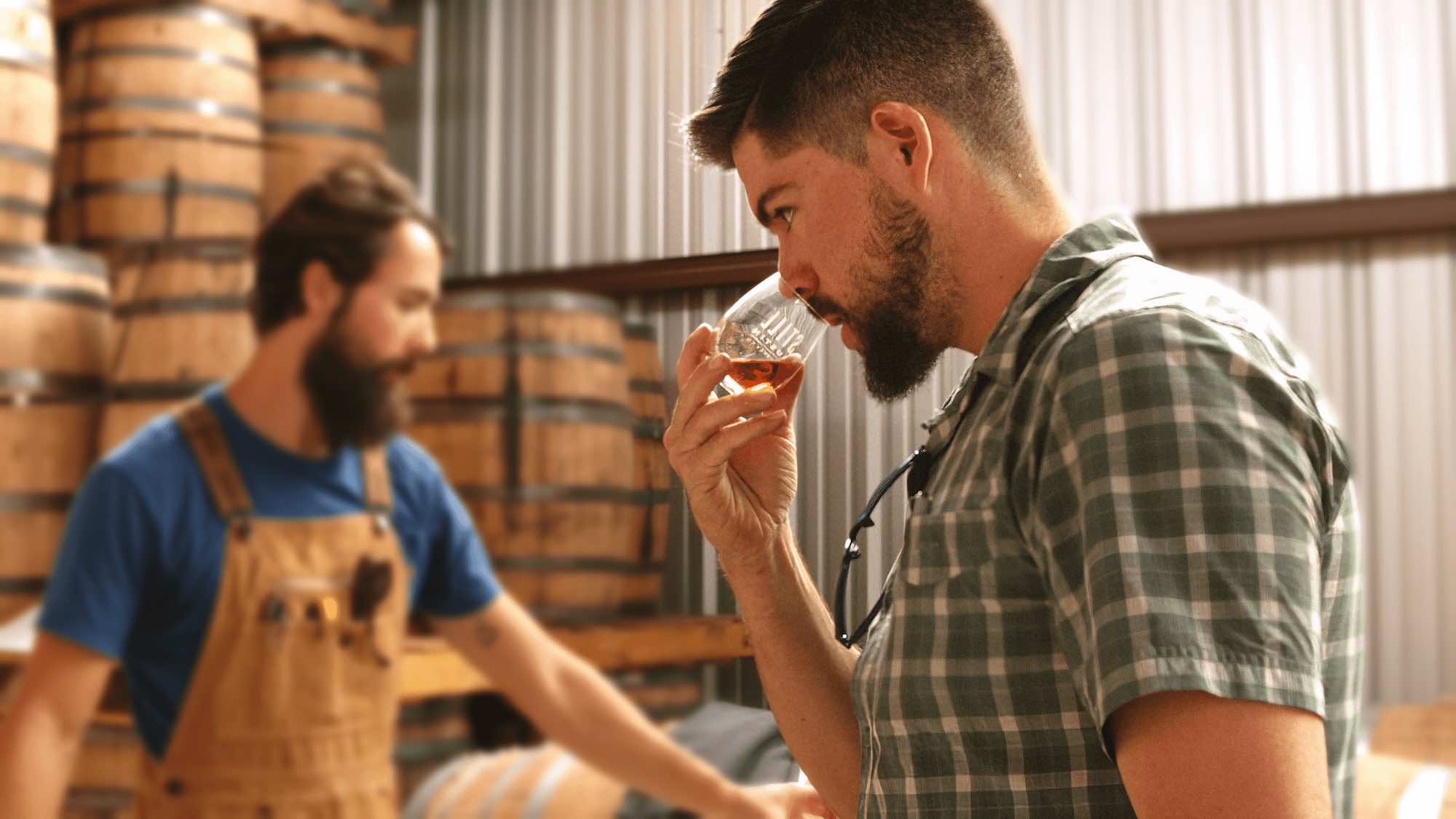Slow Water Reduction Lets Still Austin Age Longer in Texas Heat
So, to look at the back label on a bottle and read ‘produced and bottled by,’ you know you’re getting something truly from that distillery.

Less than two decades ago, most of the nation’s Bottled-In-Bond (BIB) whiskeys came from three distilleries: Heaven Hill (at least eight), James B. Beam (one) and Buffalo Trace (three). The number of BIBs on the market now has surely surpassed 100, and they’re made all across the country. Perhaps surprisingly, many are made at smaller distilleries, which is a challenge, as you’ll read below.
If you’re not familiar with BIB but are curious to know more, click here for a good explanation. If you prefer a surface skim, just know that it’s a hassle to make whiskey within BIB’s tight federal regulations—especially so if a distillery is small or new and lacks the number of barrels needed to make a regular BIB line extension.
And yet, so many small distillery owners are eagerly taking on the BIB challenge. Why? To them it’s the gold standard. Alan Laws, owner of Laws Whiskey House in Denver, put it this way: “For us, it’s a nod to American whiskey tradition. And it’s kinda badass, we think. We’re not as a big as all those great Kentucky distilleries that do bonded. But we wanted to make that commitment. It shows we’re serious about our whiskey.”
“So, to look at the back label on a bottle and read ‘produced and bottled by,’ you know you’re getting something truly from that distillery.”
To Still Austin head distiller, John Schrepel (seen in the photo up top), bonded status is a prized federal stamp of approval claiming a distillery has checked all its boxes: made at one distillery in one of two annual distilling seasons, aged at least four years in a bonded warehouse, and proofed exactly to 100.
“That the whiskey has to come from the same distilling season … means you can’t blend from other vintages,” Schrepel said. In other words, you’re stuck with a super-limited number of barrels, which is an ongoing challenge for smaller, younger distilleries. “So, to look at the back label on a bottle and read ‘produced and bottled by,’ you know you’re getting something truly from that distillery.”
That’s significant for a grain-to-glass distillery like Still Austin. Located in Austin, Texas, all its whiskeys come from Texas-grown grains. And so does all that oppressive Texas heat, which makes whiskey aging difficult. Come June, the area’s high temps start at 90 F, soar regularly beyond 100 F and don’t drop below 90 for highs until at least late September. Such weather is hard on Texas crops and a greedy consumer of water bound in barreled whiskey. Angel’s share in Texas is 10 percent per year—double that of Kentucky.
And yet, this, Schrepel will tell you, can be a good thing for those who understand nature’s rules and adjust to them. With guidance from Nancy “the nose” Fraley, whose remarkable blending skills and maturation counsel is viewed as gospel by an ever-growing list of craft distilleries, Still Austin incorporates her slow water reduction technique to offset water loss. But water replacement comes with a bonus: greater flavor extraction from the wood.

The 4-year-old mark (when Still Austin barrels average 122 proof), the team begins adding water to as many as 35 barrels. Proof is measured and written on the outside of the barrel, then six liters water of are added to the barrel. That step, said Jason Harry, Still Austin’s brand experience manager, reduces proof by volume by roughly 2 percent. Water addition happens up to four times over the course of a half year. When the whiskey is deemed ready for bottling, barrel proof is generally 108–a mere 4% ABV above the bonded maximum.
“This is us adjusting how the whiskey is operating in the barrel,” Harry said.
Schrepel called slow water reduction “a very good practice, though time consuming and labor intensive. But ultimately the whiskey turns out better.”
My palate agrees, and SA’s bottled-in-bonds are like none other. For example, BIBs from Kentucky, Indiana and Tennessee tend to present pleasantly robust at age 4. Barrel character is high, but still in balance; not over-oaked. But those same whiskeys also don’t yet display the pleasant fruit and floral characters from long-term esterification—which is to be expected from a BIB.
2024 Still Austin Red Corn Bottled-In-Bond Bourbon Review
2024 Still Austin Blue Corn Bottled-In-Bond Bourbon Review
2023 Still Austin Red Corn Bottled-In-Bond Bourbon Review
Still Austin High Rye Bottled-In-Bond Bourbon Review
SA’s BIBs highlight unique grain choices (namely red, white and blue corn varietals) that present nutty, floral, lightly candied and subtle caramel notes. They’re excellent all-around sippers that don’t overpower the palate, and they do well in cocktails.
Other BIBs I’ve tasted from Texas (perhaps five) are at least modestly over-oaked and approaching astringent. One can only assume those characters will increase over time aging in those sauna-like conditions.
“I’d love to release a high-quality bourbon at a 10- to 15-year mark someday. I don’t want ours to be a typical Texas oak bomb."
Using slow water reduction, Schrepel said, not only allows him to create Texas BIBs that aren’t over-oaked, but ones he hopes to age well beyond his oldest BIB, 2024’s 5-year-old red corn version.
“I’d love to release a high-quality bourbon at a 10- to 15-year mark someday,” said Schrepel, adding that SA’s barrel-entry proof is 118. “I don’t want ours to be a typical Texas oak bomb.”
A further step taken to ensure they don't become oak bombs is SA’s choice to use palletized rickhouses, which aren’t tall. Schrepel said that if they were six to nine stories tall like those at eastern distilleries, high floor temps would be “way too hot in Texas. We stack four stacks high with four barrels per pallet.”
SA is taking its whiskey aging in general a step further by adding 59- and 63-gallon white American oak barrels to its inventory. Schrepel believes these will allow its whiskies an additional chance to mature for even longer periods.
“Those are already very promising at 2 years,” he said. “Right now, there’s no real timeline on how long we’ll go. But if we want them to go 6, then 7 or 8 years and so forth, we can do that.”

